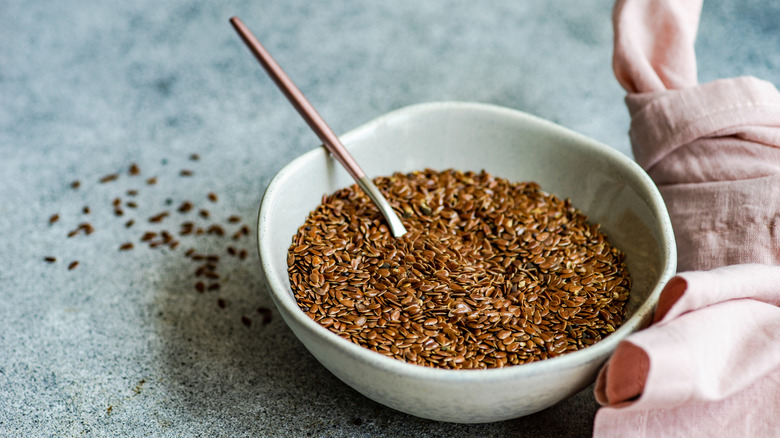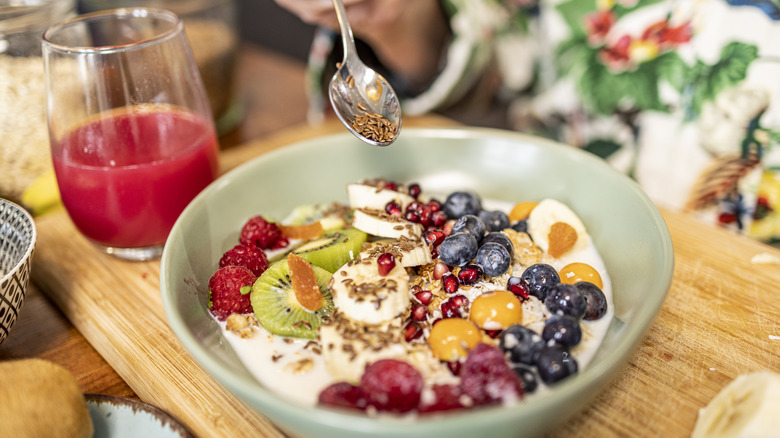
PeopleImages.com – Yuri A/Shutterstock
Many lifestyle factors can contribute to high blood pressure, such as a lack of exercise, too much alcohol, smoking, and an unhealthy diet high in sodium. When you eat can also factor into your blood pressure risk. According to a 2022 review in the International Journal of Hypertension, skipping breakfast can raise your risk of high blood pressure by 20%.
Of course, that doesn’t mean you should be reaching for donuts and a few slices of bacon for breakfast. Using the Dietary Approaches to Stop Hypertension (DASH) eating plan guidelines, breakfast may include oatmeal, whole wheat toast with peanut butter, a banana, and low-fat milk. Adding a tablespoon of flaxseed to your oatmeal may also help reduce your blood pressure.
In a Health Digest interview, Courtney Pelitera, a Registered Dietitian at Top Nutrition Coaching, explained that flaxseed has fiber and omega-3 fatty acids that help to reduce your cholesterol. “Lower total blood cholesterol levels and LDL levels have been studied to aid in the reduction of blood pressure,” she said.
The effects of flaxseed on blood pressure and heart health

Annabogush/Getty Images
Pelitera says a tablespoon of flaxseed has 2 grams of fiber and 2 grams of polyunsaturated fatty acids in just 35 calories. Those tiny seeds pack a powerful punch when it comes to lowering blood pressure. A 2016 review in Clinical Nutrition found that adding ground flaxseed to your diet can help reduce systolic blood pressure (the top number) by 1.8 millimeters of mercury and diastolic (the bottom number) by 1.28 millimeters of mercury. And the longer you stick with it, the better the results. Using flaxseed for at least 12 weeks could lower systolic blood pressure by 3.1 millimeters of mercury and diastolic by 2.6 millimeters of mercury.
(Here are some ways to lower your blood pressure without medication)
“High fiber foods such as flaxseeds are very heart healthy,” Pelitera said. “They can lower cholesterol, aid in having regular bowel movements, help with increasing satiety of food, reduce hunger in between meals, and reduce cardiovascular disease.” They may also help you lose weight, according to a 2022 study in Explore. When people added 30 grams (about 4 tablespoons) of flaxseed to their daily diets for 12 weeks, they lost weight and reduced their cholesterol levels. Their systolic blood pressure dropped by more than 13 millimeters of mercury and diastolic by more than 5 points.
The best ways to add more flaxseed to your diet

Ems-forster-productions/Getty Images
“Flaxseed added to a healthy, whole food diet can make a big difference,” Pelitera said. “How much you are going to want to consume depends on what the rest of your diet looks like.” You may not notice much of a difference if you already follow a high-fiber diet. If you need a little more fiber in your diet, Pelitera recommends starting with 1 or 2 tablespoons of flaxseed a day. Be sure to drink plenty of water to avoid digestive issues.
(Read why flaxseeds could be the key to aging well.)
Before you top your oatmeal with a tablespoon of flaxseeds, Pelitera recommends grinding them so they’re easier to digest. Otherwise, they can pass right through your system without delivering their key nutrients. Instead of limiting flaxseed to just one food or meal, Pelitera suggests incorporating it throughout your day. For example, you can add a tablespoon of ground flaxseed to your cereal, oatmeal, or yogurt. A few tablespoons in your smoothie boost fiber without you even noticing. Try mixing ground flaxseed into your baking recipes, such as muffins or cookies, for a heart-healthy twist. You can also sprinkle whole or ground flaxseed over salads or pasta to get more omega-3s.
Credit: healthdigest.com









